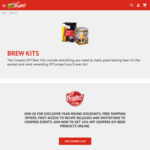In readiness for Father's Day, Coopers have released their two beer kits at a reduced price. These kits are ridiculously easy to use and come with everything you need to start making decent beer. You shouldn't stop there but go have a look at the Coopers DIYBeer site and investigate some of the recipes that are on there. I have just made their Lamington Stout Recipe of the Month and it was simple, straightforward and bloody lovely.
There are an abundance of recipes on the Coopers site - https://www.diybeer.com/au/recipes/ which detail everything needed and the steps to follow.
There are also a number of videos on the site that show the basics of how to start - https://www.diybeer.com/au/brewing-support/
Forget the old preconceptions that kit beer is bland, the craft beer revolution in the commercial industry has paved the way for some quality, tasty beers to be possible in your own home with minimal fuss.
Lastly the Coopers site has an active community who can help point you in the right direction if you need a little guidance - https://community.diybeer.com/
If this is a Fathers Day gift the the following are the guaranteed cut off times for delivery:
WA/NT Metro - 20 Aug
SA/TAS Metro - 21 Aug
NSW/QLD/VIC Metro - 28 Aug
All other areas 19 Aug


8.5 L kit could be good for apartment in a bag brewing. Mash 1kg ish of grain in a large stockpot.
But then again it’s just food safe plastic I’ve fermented in the $4 10L water Containers.